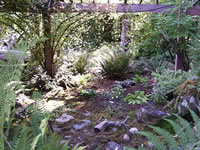The Tasks and Gardening Chores of March
March is the month when many of the beautiful spring flowering perennials and shrubs begin to bloom. Aubrietia, Candytuft, Rock Cress, Bergenia, Snowdrops, Witch Hazel and many others will soon be brightening your days.
With Spring just around the corner, it is time to get serious and get the garden ready! The fickle weather of March makes it impossible to set exact dates and schedules for planting, so proceed with caution!
Shrub and Tree Care

In most areas it is still possible to do dormant spraying of fruit trees until the 15th. After that date dilute the spray by 1/2. Spraying should only be done on a still day with the temperature above 40 degrees F.
You can still safely transplant Azaleas and other small shrubs as long as the flower buds haven't swelled or broken open.
Fertilize shrubs and trees if this wasn't done in February. Use an acid type rhododendron fertilizer to feed evergreens, conifers, broad leaf evergreens, Camellias, Rhododendrons and Azaleas. Use an all-purpose fertilizer to feed Roses and other deciduous trees and shrubs. If you use granular type fertilizers, be sure to water it in thoroughly.
Finish pruning fruit trees this month - before the buds swell!
Annuals, Perennials and Bulbs in the Garden
There is often a strong temptation to start removing winter mulches from your flower beds.... WAIT!!! Pull the mulch off gradually as the plants show signs of new growth. The purpose of winter mulch is to act as a protector from sudden changes of temperature and chilling winds, so keep in mind that it is still winter. Acclimatize your plants by removing the mulch over a period of days, allowing the light and air to reach the new growth slowly. It is much better to remove the mulch a little later than to remove it to early.
Roses can be pruned this month. Severe pruning results in nicer long stemmed flowers and more compact bushes. Begin to spray roses for blackspot. Feed roses.
Sow seeds of summer blooming annuals indoors. Seeds that were started indoors last month may be transplanted from the flats into peat pots and given dilute fertilizer.
If you have a greenhouse, it is time to take cuttings of 'wintered over' plants such as Coleus, Chrysanthemums, Geraniums.
Alternating thawing and freezing can tear plant roots and even force the plant right out of the ground. If you notice any plants that have heaved, push them back into the soil, and tamp the dirt lightly with your foot.
Divide and transplant summer blooming perennials and fertilize established ones as soon as new growth appears.Plant tender bulbs and tubers like Gladiolas, Lilies and Dahlias. You can continue planting additional bulbs every two weeks until mid June to ensure a continuous source of bloom.
Prune Winter Jasmine after flowering. Cut Honeysuckle vines back to 3ft.
Cut back established Penstemons. Divide Snowdrops while in leaf.
Remove all spent blooms from bulbs, but leave the foliage in place.
Fertilize any bulbs that have finished blooming with bone meal or bulb booster.
Pinch off tips of Sweet Pea seedlings and Chrysanthemums, when they are 4 inches tall.Fruit and Vegetable Gardening
Take a little time to prepare the vegetable garden soil for planting. The addition of well-rotted manure, processed manure, peat moss or compost are good additives for building humus in the soil.
Peas and Sweet Peas may be planted right now as well as perennial vegetables like Asparagus, Rhubarb, Horseradish and Artichokes. Eggplant, Brussels Sprout, Cauliflower, Celery, Leek, Onions, Radish seeds and early potatoes can be planted in the garden about mid month.
Spinach, Chard, Cabbage, Cauliflower, and other hardy vegetables can be seeded or set out late in the month.
Plant Strawberries, Blueberries, Currants, Loganberries, Boysenberries, Grapes and fruit trees.
Add some steer manure around your Rhubarb.
Its time to start Tomatoes, Lettuce, and many other vegetable seeds indoors.
House Plant Care
House plants will react to longer days and brighter light at this time by putting out new growth. The end of this month is a good time to pinch them back to generate new growth and to thicken them.
You can then begin fertilizing again with a dilute solution of soluble house plant food.
Turn your houseplants a quarter turn each week to make sure all sides of the plant receive adequate light, and to keep the shape of the plant balanced.
Mist or spray your houseplants to clean away the winters dust, prevent Spider Mites and add a little humidity.
Remain vigilante in watching for insects and pests. It is much easier to win a 'bug war' if you are aware of the infestation in it's early stages.
Odds and ends
The most dreaded task of all is weeding, but it is one that really needs to be accomplished before the weeds have a chance to flower and go to seed. Remember once the weeds go to seed you can be fighting that weed seed for up to seven years or more. Most weeds can simply be pulled or cultivated out of the garden while they are young.
Turn the compost pile, adding any course mulch which was removed from the garden to it.
Keep an eye out for Aphids (spray off with water) and Cutworms (Cutworm Dust).
Repair damaged areas of the lawn.... Dethatch, rake or aerate. Apply Dolomite Lime to sweeten the soil if needed. Most lawns will need a spring feeding but if thatching or liming needs to be done, do those jobs first. If moss is a problem, a combination fertilizer and moss killer can be applied, to do both jobs in one easy application. Over-seeding can be done as the last step, after the lawn has been fertilized.
Test your soil for pH to see if any amendments are necessary. A general rule of thumb is to add 4 lbs. of lime per 100 sq. ft. of garden for every pH point below 6.5, or 1 lb. of sulfur per 100 sq. ft. for every pH point above 7.5. Sawdust, composted oak leaves, wood chips, peat moss, cottonseed meal, and leaf mold lower the pH while ashes of hardwoods, bone meal, crushed marble, and crushed oyster shells raise the pH. The best way to adjust pH is gradually, over several seasons.
March is a good time to note areas of poor drainage. If there are pools of water in your yard that do not drain. Fill in the low spot or scoop out a channel for the water to drain away.
Clean out all of your birdhouses now, so that they will be ready when the birds return.
Repair any fencing, arbors, or trellis work that is weak or has broken over the winter ... before you get too busy!
Check the plants under the eaves of the house and under tall evergreens to see that they have sufficient moisture.
